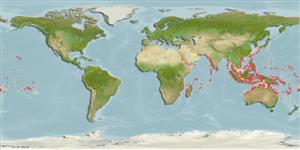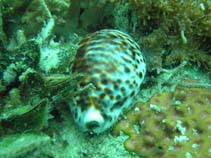Cypraea tigris Linnaeus, 1758
Tiger cowrie| Native range | All suitable habitat | Point map | Year 2050 |

|
| This map was computer-generated and has not yet been reviewed. |
| Cypraea tigris AquaMaps Data sources: GBIF OBIS |
Classification / Names Common names | Synonyms | CoL | ITIS | WoRMS
Gastropoda | Littorinimorpha | Cypraeidae
Environment: milieu / climate zone / depth range / distribution range Ecology
Benthic; depth range 0 - 30 m (Ref. 349). Tropical; 35°N - 34°S, 30°E - 138°W
Distribution Countries | FAO areas | Ecosystems | Occurrences | Introductions
Indo-Pacific.
Length at first maturity / Size / Weight / Age
Maturity: Lm ? range ? - ? cm Max length : 16.0 cm SHL male/unsexed; (Ref. 349); common length : 9.0 cm SHL male/unsexed; (Ref. 349)
Commonly collected for food in many parts of the area, mainly in the shallow water zone. Shell used for shellcraft. Due to frequent over collecting and destruction of the coral reef environment by dynamite fishers, this species may be nearly extinct locally or confined to the deeper part of its habitat (to depths over 10 m) (Ref. 349). Known to be abundant in reef areas, on sand, among rocks (Ref. 128042), on branched corals, often nearby seaweeds. Active during the day (Ref. 349). Omnivore (Ref. 112158). In general, cowries are observed to feed on sponges, live gastropods, seaweed, and carrion (Ref. 112163).
Life cycle and mating behavior Maturity | Reproduction | Spawning | Eggs | Fecundity | Larvae
Members of the order Neotaenioglossa are mostly gonochoric and broadcast spawners. Life cycle: Embryos develop into planktonic trocophore larvae and later into juvenile veligers before becoming fully grown adults.
Main reference
References | Coordinator | Collaborators
Poutiers, J.M. 1998. (Ref. 349)
IUCN Red List Status (Ref. 130435)
CITES status (Ref. 108899)
Not Evaluated
CMS (Ref. 116361)
Not Evaluated
Threat to humans
Harmless
Human uses
Fisheries: commercial
| FishSource | Sea Around Us
Tools
More information
Internet sources
BHL | BOLD Systems | CISTI | DiscoverLife | FAO(Publication : search) | Fishipedia | GenBank (genome, nucleotide) | GloBI | Gomexsi | Google Books | Google Scholar | Google | PubMed | Tree of Life | Wikipedia (Go, Search) | Zoological Record
Estimates based on models
Preferred temperature
(Ref. 115969): 25.4 - 29.3, mean 28.7 (based on 2229 cells).
Price category
(Ref. 80766):
Unknown.
Nutrients: Calcium = 126 [75, 177] mg/100g; Iron = 4.79 [1.67, 7.92] mg/100g; Protein = 15.9 [14.8, 16.9] %; Omega3 = 0.331 [0.263, 0.400] g/100g; Selenium = 57.8 [48.5, 67.2] μg/100g; VitaminA = 0 μg/100g; Zinc = 1.97 [0.92, 3.02] mg/100g (wet weight).



